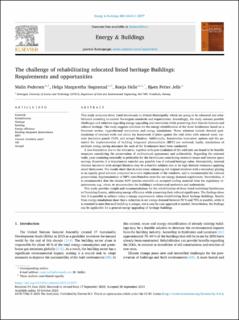| dc.description.abstract | This study evaluates three listed farmhouses in Ørland Municipality which are going to be relocated and rehabilitated according to current Norwegian standards and requirements. Accordingly, the study assesses possible challenges and solutions regarding energy upgrading and restoration while preserving their historic features and cultural heritage. The study suggests solutions for the energy rehabilitation of the three farmhouses based on a literature review, hygrothermal simulations and energy simulations. These solutions include thermal post-insulation of external walls and above the framework of joists against the cold attics with mineral wool, vacuum insulation panels (VIP), and aerogel blankets. Additionally, fenestration renovation options and the potential for implementation of building integrated photovoltaics (BIPV) are reviewed. Lastly, simulations of multiple energy-saving measures for each of the farmhouses have been conducted.
A new foundation due to the relocation, together with post-insulation of the cold attic are found to be feasible measures considering the preservation of architectural appearance and authenticity. Regarding the external walls, post-insulating externally is preferable for the farmhouses considering moisture issues and interior space savings. However, it is important to consider any possible loss of cultural heritage value. Alternatively, internal thermal insulation with aerogel blankets may be a feasible solution due to its high thermal resistance applying small thicknesses. The results show that in some cases, enhancing old original windows with a secondary glazing is an equally good solution compared to a total replacement of the windows, and is recommended for cultural preservation. Implementation of BIPV contributed to meet the net energy demand requirement. Nevertheless, it is recommended that the chosen BIPV systems resemble an accepted roofing material from the regulatory requirements, e.g., slates, to accommodate the building’s architectural aesthetics and authenticity.
This study provides insight and recommendations for the rehabilitation of three listed traditional farmhouses in Trøndelag County, addressing energy efficiency while preserving their cultural significance. The findings show that it is possible to achieve today’s energy requirements when rehabilitating listed heritage buildings. Results from energy simulations show that a reduction in net energy demand between 55 % and 75% is possible, while it is essential to note that each building is unique, and a case-by-case approach is needed. Nevertheless, the findings can be applicable for a general energy upgrading of heritage buildings. | en_US |

